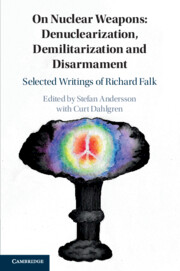 On Nuclear Weapons: Denuclearization, Demilitarization and Disarmament
On Nuclear Weapons: Denuclearization, Demilitarization and Disarmament Book contents
- On Nuclear Weapons: Essays by Richard Falk on Denuclearization, Demilitarization, and Disarmament
- On Nuclear Weapons: Essays by Richard Falk on Denuclearization, Demilitarization, and Disarmament
- Copyright page
- Dedication
- Epigraph
- Contents
- Foreword by Zia Mian
- Preface by Richard Falk
- Acknowledgments
- Part I International Law and World Order
- Part II Impacts of Democracy, Neutrality, and National Interest
- Part III Nuclear Policy Initiatives
- Part IV Remembering the Past, Encountering the Future
- Index
- References
Part I - International Law and World Order
Published online by Cambridge University Press: 04 July 2019
- On Nuclear Weapons: Essays by Richard Falk on Denuclearization, Demilitarization, and Disarmament
- On Nuclear Weapons: Essays by Richard Falk on Denuclearization, Demilitarization, and Disarmament
- Copyright page
- Dedication
- Epigraph
- Contents
- Foreword by Zia Mian
- Preface by Richard Falk
- Acknowledgments
- Part I International Law and World Order
- Part II Impacts of Democracy, Neutrality, and National Interest
- Part III Nuclear Policy Initiatives
- Part IV Remembering the Past, Encountering the Future
- Index
- References
Summary
In May of 1955 five individuals instituted a legal action against the Japanese government to recover damages for injuries allegedly sustained as a consequence of the atomic bombings of Hiroshima and Nagasaki in the closing days of World War II. On December 7, 1963, the twenty-second anniversary of the surprise attack by Japan upon Pearl Harbor, the District Court of Tokyo delivered its lengthy decision in the case. The decision has been translated into English and reprinted in full in The Japanese Annual of International Law for 1964. This enables an accounting of this singular attempt by a court of law to wrestle with the special legal problems arising from recourse to atomic warfare.
The Japanese court reached the principal conclusion that the United States had violated international law by dropping atom bombs on Hiroshima and Nagasaki. It also concluded, however, that these claimants had no legal basis for recovering damages from the Japanese government.
- Type
- Chapter
- Information
- On Nuclear Weapons: Denuclearization, Demilitarization and DisarmamentSelected Writings of Richard Falk, pp. 1 - 136Publisher: Cambridge University PressPrint publication year: 2019
